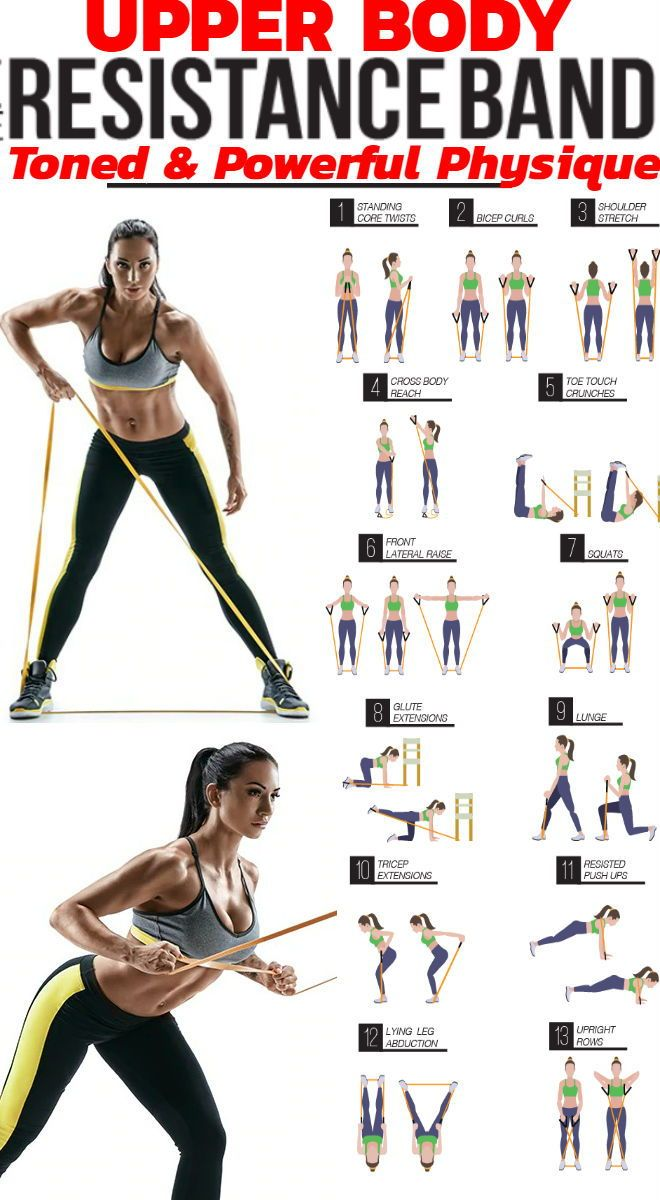Resistance band exercises are a powerful and versatile addition to any fitness routine, whether you’re at home or the gym. These flexible tools provide a unique method for challenging your muscles and enhancing your strength training regimen. With resistance bands, you can perform a wide variety of workouts that engage multiple muscle groups, promoting balanced development and functionality. Not only do they offer the benefits of resistance training, but they also allow for greater freedom of movement, making them suitable for all fitness levels. Whether you’re new to workout with resistance bands or looking to diversify your existing routine, integrating band exercises can lead to impressive results and improved overall fitness.
Incorporating elastic resistance tools into your fitness regimen opens up a world of possibilities for enhancing strength and endurance. Utilizing stretchable bands can transform your workouts into dynamic sessions that target various muscle groups effectively. Home workouts with bands are an excellent option for anyone looking to maintain an active lifestyle, especially when traditional weights are not available. These adaptable tools can be used for a myriad of exercises, providing resistance that scales with your strength and experience. Embrace the full potential of these band workouts to achieve your fitness goals and enjoy a more engaging training experience.
The Advantages of Resistance Band Exercises
Resistance band exercises are gaining popularity in the fitness community due to their versatility and effectiveness in strength training. Unlike traditional weights, resistance bands provide variable resistance, meaning that as you stretch the band, the tension increases. This unique property not only targets your muscles differently but also enhances the engagement of stabilizer muscles, offering a comprehensive workout approach. By integrating these bands, you can achieve optimal muscle activation and challenge your body in new ways, making them a powerful tool for both beginners and seasoned athletes.
Another significant advantage of using resistance bands is their portability and ease of use. Whether you’re in a gym, at home, or traveling, resistance bands are lightweight and can be easily stored in a bag. This convenience allows you to maintain a consistent workout routine without the need for bulky equipment. Additionally, resistance bands cater to various fitness levels; they are available in different thicknesses, which gives you the freedom to adjust the resistance as needed. Incorporating these bands into your workouts can help improve strength, flexibility, and overall functional fitness.
Incorporating Band Exercises into Your Home Workouts
For those who prefer to workout at home, resistance bands are an excellent addition to your fitness arsenal. They can effectively replace traditional weights for numerous exercises, allowing you to perform full-body workouts without needing a gym membership. For instance, exercises like banded squats, push-ups with bands, and seated rows deliver significant muscle engagement with minimal setup. A home workout utilizing resistance bands can be just as challenging and effective compared to lifting weights.
Moreover, resistance bands foster a creative approach to exercising at home. You can easily mix and match exercises to design your own routines tailored to specific goals, be it strength building, rehabilitation, or general fitness. Including band exercises can also help keep your workouts dynamic and engaging, reducing the risk of boredom that may arise from repetitive traditional workouts. Plus, resistance bands can help target specific muscle groups that might be overlooked with conventional equipment.
Maximizing Your Gains with Resistance Bands
To truly maximize the benefits of resistance bands, it is essential to integrate them into a well-rounded fitness program. This includes proper warm-ups and cooldowns, along with varying your resistance band selection to continue challenging your muscles. For example, start with lighter bands for warm-up sets, then progressively increase resistance for your main workout. This approach can lead to improved strength gains and muscle endurance over time.
Another key aspect of using resistance bands effectively is focusing on form and control during each exercise. Unlike lifting free weights, the resistance from bands can sometimes lead to faster movements, which might sacrifice form. It’s crucial to maintain steady and controlled motions to engage the targeted muscles properly. Therefore, consciously slowing down and focusing on the contraction and lengthening of muscles during each rep can amplify your results, helping to develop a well-defined physique over time.
The Science Behind Resistance Band Workouts
Understanding the science behind resistance band workouts enhances your ability to use them effectively. Resistance bands function on the principle of accommodating resistance, where the level of difficulty adjusts according to the stretch. This ensures that muscles are put under tension throughout the entire range of motion, offering unique challenges compared to fixed-weight exercises. Moreover, researchers have found that incorporating resistance bands into routines can lead to significant increases in muscle strength and power.
Additionally, the muscle activation patterns experienced during resistance band workouts differ due to the continuous tension provided by the bands. This can lead to greater muscle fiber recruitment, which is essential for muscle growth. Research supports the claim that when trained with bands, individuals may experience improved strength gains, especially in stabilizing muscles that are often neglected during traditional training methods. Thus, resistance band workouts can be an excellent choice for comprehensive muscle development.
Common Mistakes to Avoid When Using Resistance Bands
While resistance bands are beneficial, certain mistakes can hinder your results. One common issue is using bands that are too light, leading to insufficient tension and, consequently, minimal muscle engagement. It is crucial to assess your current strength levels and select bands that sufficiently challenge your muscles throughout your workout. Opting for a variety of bands can help strategically target different muscle groups more effectively.
Another mistake many make is not paying attention to their form. Just like with free weights, maintaining proper posture while using resistance bands is essential to prevent injuries and ensure effective workouts. Many users tend to rush through exercises, which can lead to improper form. Taking the time to master your technique not only maximizes results but also helps you avoid unnecessary strain or injury.
Full-Body Workouts with Resistance Bands
Full-body workouts with resistance bands are an excellent way to engage multiple muscle groups simultaneously. Exercises such as banded squats, rows, and overhead presses can be performed seamlessly, ensuring a balanced approach to strength and conditioning. By leveraging the bands for compound movements, you can work on functional strength, which is beneficial in everyday activities.
To create an effective full-body workout, pair pushing and pulling exercises with lower body movements. For instance, integrating a banded deadlift with a press or row helps maintain muscle engagement across various areas, providing a comprehensive fitness solution. Additionally, you can adapt the exercises for different fitness levels, making them suitable for everyone from beginners to advanced athletes.
Benefits of Resistance Bands in Physical Rehabilitation
Resistance bands play a crucial role in physical rehabilitation due to their versatility and controlled resistance levels. They offer a safe way to gradually strengthen muscles following an injury, making them particularly useful for rehabilitation programs. Physical therapists often incorporate resistance bands to help patients improve range of motion, increase strength, and restore functionality without the risk of overloading damaged tissues.
Furthermore, resistance bands allow for a wide array of rehabilitation exercises that can be customized to meet an individual’s needs. For instance, gentler band exercises can be used for individuals recovering from surgery or injury, while those looking to regain strength can use bands to increase the difficulty of movements. This adaptability makes them essential tools in various rehabilitation settings, ensuring users develop stability and strength necessary for long-term recovery.
Choosing the Right Resistance Bands
Selecting the right resistance bands is vital to an effective workout. Resistance bands come in various thicknesses and lengths, each providing different levels of resistance. Lighter bands are ideal for beginners or rehabilitation, allowing for gentle resistance, while heavier bands are better suited for those looking to increase strength or add intensity to their workouts. Understanding your personal fitness level can aid you in choosing bands that maximize your workout’s effectiveness.
Additionally, consider the type of resistance band that best suits your training style. Loop bands are great for lower body exercises, while tube bands with handles are versatile for both upper and lower body workouts. By selecting the right band type and resistance level, you can ensure a more engaging workout that meets your fitness goals while reducing the risk of injury.
Enhancing Athletic Performance with Resistance Bands
Athletes are increasingly turning to resistance bands to enhance their performance across various sports. These bands can improve strength, coordination, and agility, essential components for optimal performance. Implementing resistance band exercises targeting specific muscle movements that are relevant to your sport can lead to significant gains in speed and power.
Furthermore, resistance bands help in developing explosiveness. For instance, exercises like banded sprints can activate fast-twitch muscle fibers, which are crucial for quick bursts of speed. By incorporating such dynamic movements into training, athletes can improve their overall athleticism, creating a more competitive edge in their respective sports.
Frequently Asked Questions
What are the benefits of resistance band exercises?
Resistance band exercises offer a versatile and effective workout option that enhances strength, flexibility, and stability. They provide accommodating resistance, meaning the more you stretch the band, the greater the challenge, which effectively engages muscle fibers throughout your workouts. Additionally, resistance bands can easily be used at home, making them ideal for home workouts.
How can I incorporate resistance bands into my home workouts?
You can incorporate resistance bands into your home workouts by mixing and matching various band exercises. Create a routine that includes push, pull, and leg movements with resistance bands. Consider full-body workouts or specific targeted exercises like the Pallof Press or plank variations to maximize your results.
What are some effective band exercises for beginners?
Effective band exercises for beginners include simple movements such as band pull aparts, rotator cuff warm-ups, and seated rows. These exercises help build strength and familiarize you with using resistance bands safely and effectively.
Can resistance bands help improve my strength training?
Yes, resistance bands can significantly improve your strength training by adding resistance without placing excessive strain on your joints. They offer unique resistance variations that enhance muscle engagement and can be combined with traditional weightlifting to increase workout efficiency.
How do resistance band workouts compare to traditional gym workouts?
Resistance band workouts provide similar benefits to traditional gym workouts but with added versatility and portability. Bands can activate muscles differently by providing variable resistance throughout the movement, making them an excellent complement to free weights or machines.
What’s the best way to use resistance bands for a full-body workout?
To effectively use resistance bands for a full-body workout, include exercises that target major muscle groups. For example, perform alternated pulls, squats, chest flies, and abdominal movements, ensuring you balance push and pull exercises for comprehensive strength development.
How many sets and reps should I do with resistance band exercises?
For most resistance band exercises, aim for 3 sets of 8-12 repetitions. Adjust the resistance level and number of repetitions as needed to match your fitness level and ensure you are challenging your muscles appropriately.
Are there any safety tips for using resistance bands during workouts?
Absolutely! Always inspect your resistance bands for wear or damage before use. Ensure you’re using appropriate resistance for your strength level, and anchor bands securely to prevent slips. Maintain proper form and control throughout each movement to avoid injuries.
What equipment do I need to start with resistance band exercises?
To get started with resistance band exercises, you need a set of resistance bands in different resistance levels and an anchor point for certain exercises, such as a closed door or sturdy post. A workout mat can also be useful for floor exercises.
Can I use resistance bands for rehabilitation exercises?
Yes, resistance bands are widely used for rehabilitation exercises due to their ability to provide low-resistance training options. They are effective for improving strength and flexibility without putting undue stress on injured or recovering muscles.
| Exercise Name | Purpose | Instructions |
|---|---|---|
| Rotator Cuff Shoulder Warmup | Strengthens shoulder muscles | Perform external and internal rotations, low lat pulls, band pull aparts, and archer rows with 30 reps each. |
| Pallof Press | Challenges core stability against rotation | From a kneeling position, grasp the band and extend outward, aiming for 3 sets of 8-10 reps. |
| Copenhagen Plank Mini Band Challenge | Increases plank difficulty | Place a mini band around feet in plank position and drive the bottom knee forward. |
| Half-Iso Kneeling Straight-Arm Pulldown | Activates back and core | Kneel and pull band diagonally from a high anchor. |
| Chaos Band L-Sit Chinup | Builds chin-up strength, challenges core | Using a chaos band, pull legs up while performing chin-ups. |
| Ground-Pound Alternating Press | Develops chest and core | From a kneeling position, alternate punching down with the bands. |
| Crucifix Arm Finisher | Targets arms and shoulders | Perform curls and tricep extensions from a kneeling position. |
| Half-Kneeling Archer Row | Builds mid-back strength | Half-kneel and pull band back in sets of 8-10 reps. |
| Plank Triceps Kickback | Strengthens arms and core | In a low plank position, pull band down for tricep extensions. |
| Chest Fly Finisher | Engages chest muscles | With bands anchored above hip level, perform alternating flys. |
| Face Pull | Improves shoulder stability | Anchor band at face height and pull towards face in goal post position. |
| Banded Row to Curl | Works back and biceps | Sit with legs straight, perform rows followed by curls in sets of 3. |
Summary
Resistance Band Exercises can significantly enhance your fitness routine by providing versatile and effective ways to build strength anytime, anywhere. These exercises challenge various muscle groups through unique forms of resistance, making them a valuable addition to any workout regimen. From warmups to focused strength training, the effective use of resistance bands can lead to improved muscle performance and overall body conditioning.



